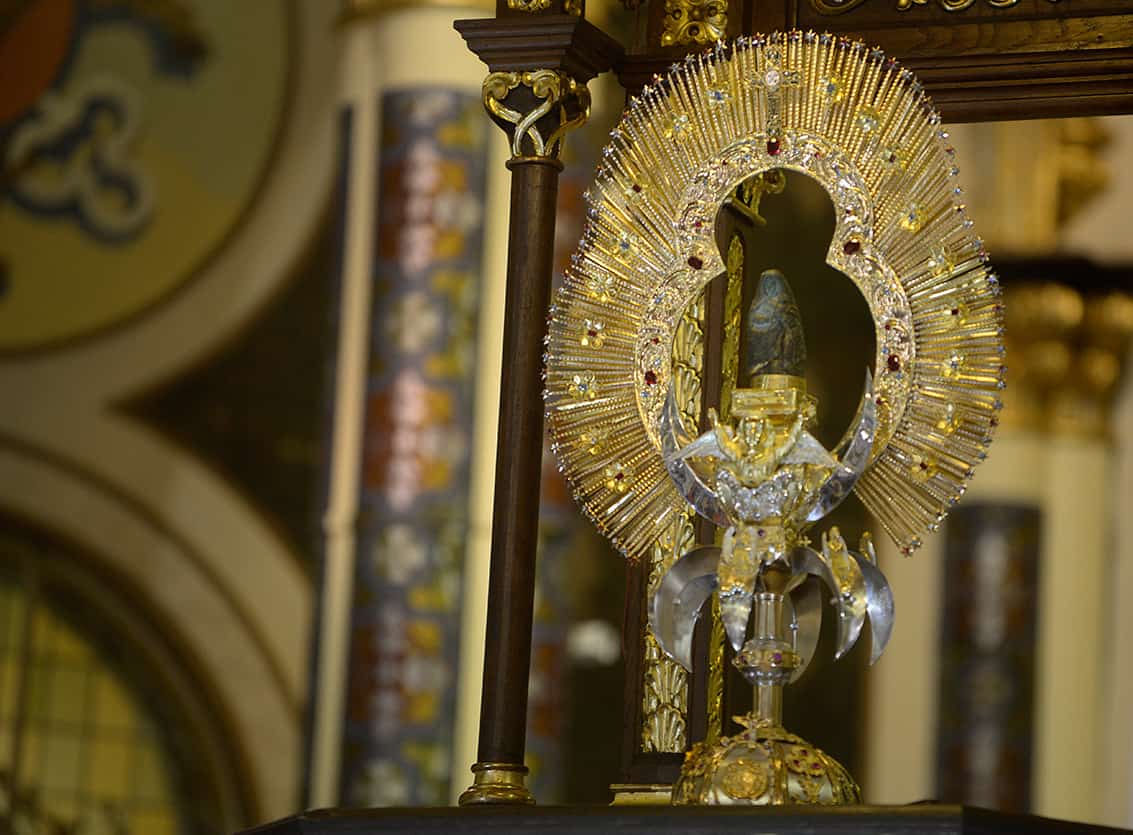CARTAGO – Victor Solís and his daughter Maria Daniela sit on small flight of stairs across from the municipal park in the city of Tres Ríos, changing their socks and massaging their feet. The green mountains of the Central Valley rise up in front of them.
“You’ve got to take care so you don’t lose a toenail,” said Solís as he slipped on a clean white sock over his left foot. And he should know; he’s walked the pilgrimage to the Basilica Nuestra Señora de los Ángeles in honor of Costa Rica’s patron saint, “La Negrita,” three times now, twice with his 16-year-old daughter.
“We’re already ahead of schedule from last year,” the 49-year-old Solís observed, hoping they could finish the walk in less than seven hours.
Every year, the faithful walk to Cartago’s picturesque Basilica to pay homage to the Virgin of the Angels and ask for her favor. People from across Costa Rica, Central America, and even farther, make their bargains with La Negrita, an affectionate nickname for the tiny black stone statue of the Madonna and child that embodies the saint.
On Friday, the Basilica hosted a mass in honor of the Virgin. Last year, the Catholic Church reported that over 2 million pilgrims made the journey.
The Solís family traveled from Palmar Norte, a city in the remote southwestern Osa Peninsula, to San José, the capital, where Friday morning they started their 22-kilometer walk, known here as the romería, to Cartago’s Basilica. The family walks on behalf of one of the daughters, who is developmentally disabled.
“We’re hoping that the Virgin can help her do a little more every year,” the father said. Another 16 year-old from San José told The Tico Times that this is the fourth romería she’s walked, starting when she was 12. Accompanied by her two sisters and a friend, the girls are walking in hopes that the hard times that befell their family this year will soon pass.
During the last week, onlookers could spot small groups of romeros, or pilgrims, walking from all over the country, usually identified by their backpacks and sportswear. Costa Rican President Laura Chinchilla started her last romería as president this year on Thursday, Aug. 1, starting at the Casa Presidencial, in Zapote, San José, reported the daily La Nación.
The road to Cartago is dotted with EcoRomería stations, where pilgrims can recycle their trash, and police and Red Cross aid stations. Pilgrims walk, run, rollerblade and ride horseback down the highways and side streets that climb the Central Valley’s verdant hills past Tres Ríos, up to Ochomogo and finally back down again to Cartago.
As the romeros enter Cartago, the scene changes dramatically. The staccato beat of helicopters overhead occasionally interrupts the din of the crowd as car traffic snarls to a stop. Men on stilts meander through the crowds with placards advertising Papa John’s pizza.
Stalls sell last minute rosary beads and dark green bottles shaped like the Virgin to collect holy water from the Basilica’s famous spring. A small sign advertises a bathroom for 300 colones, roughly 50 cents. Pilgrims pour into the wide plaza in front of the gray and white Basilica and queue to enter the country’s most iconic place of worship.
“There are just so many miracles,” says Marvin Salas, a taxicab driver from Nicoya, Guanacaste, as he remembers his brother’s recovery from a serious illness doctors believed was terminal. “I prayed for health, work, and the well-being of the country,” he told The Tico Times.
Some romeros walk part of the pilgrimage barefoot to show their devotion, but most end the journey on their knees as a final act of homage after they pass through the church doors. Pilgrims shuffle or crawl towards the golden alter, many capturing the moment on their smartphones, even an iPad.
One small boy with spiked hair lends his mother his shoulder to lean on as she makes her way down the brown, yellow and white tile floor on her knees, grimacing. Some are overcome with emotion and cry. One woman faints.
The Virgin, a small black stone statue wearing an ornate golden robe, receives the faithful atop the altar surrounded by a halo of gold and flanked by an honor guard of four uniformed men. The smells of smoldering copal and other incense perfume the air.
Along the Basilica’s aisles more pilgrims push toward the altar to give their thanks and ask favors of the Virgin. An attendant in a yellow volunteer’s shirt gently but repeatedly reminds romeros to keep their prayers short so that others can see La Negrita.
Back on to the street, crowds line up again, this time to eat at restaurants or enter the temporary tents selling everything from churros, to corn on the cob, arroz cantonés, grilled meats, stuffed and fried corn pockets called pupusas, and candied apples.
Lottery ticket sellers hawk their numbers to pilgrims who perhaps asked the Virgin for the winning combination. Lissette Pérez, a Salvadoran woman who moved to Costa Rica four years ago, sells tickets near the dark green statue of the Virgin of the Angels in the Basilica’s plaza.
When asked if sales were good, she responded that they were fair but that there were more important things than money today, adding that she was pregnant and struggling with several health issues. “I promised the Virgin that if I could have the baby, I would bring it to see her next year,” she said.






